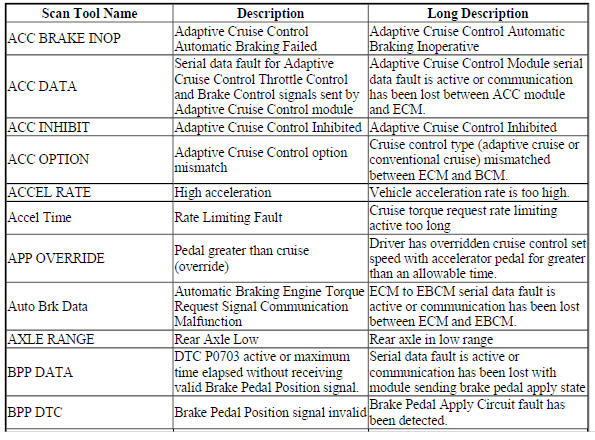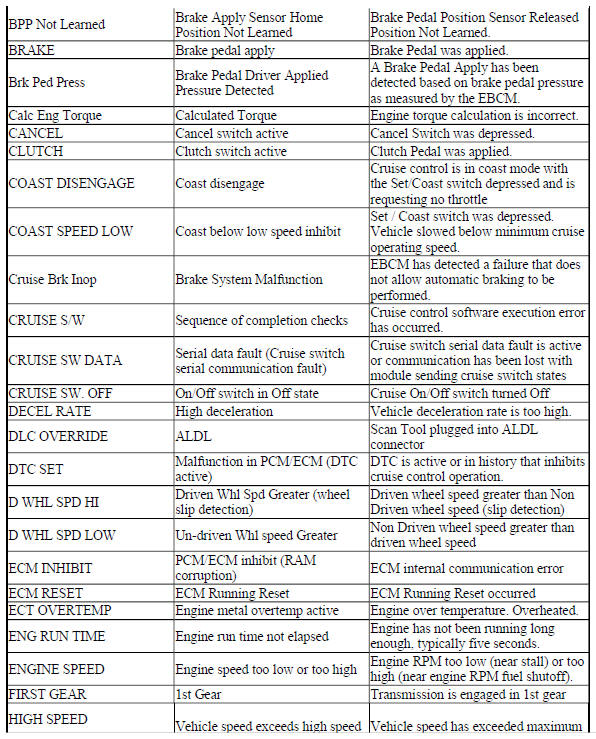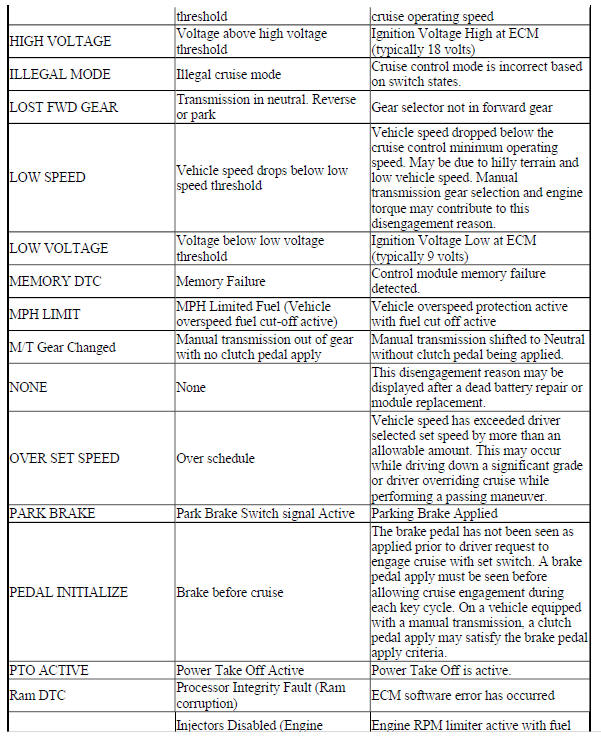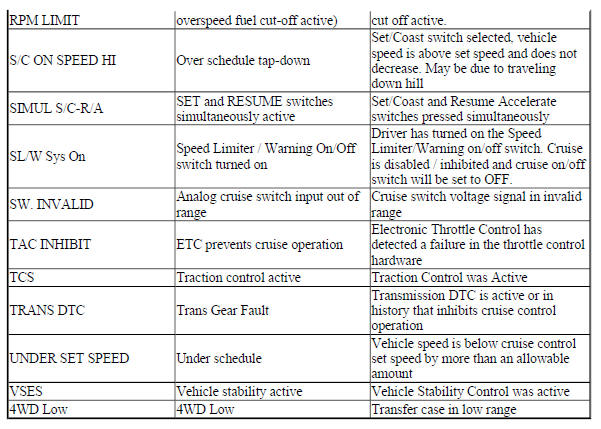Chevrolet Trax: Cruise Control - Description and operation
CRUISE CONTROL DESCRIPTION AND OPERATION
Cruise Control System Block Diagram
.gif)
Fig. 4: Identifying Cruise Control System Block Diagram
.jpg)
Cruise control is a speed control system that maintains a desired vehicle speed under normal driving conditions at speeds above 40 km/h (25 mph). Steep grades may cause variations in the selected vehicle speeds.
The following are the main components of the Cruise Control System:
- The accelerator pedal
- The brake pedal position (BPP) sensor
- The body control module (BCM)
- The cruise on/off switch
- The cruise control cancel switch
- The + RES switch (equivalent to resume/accel switch)
- The - SET switch (equivalent to set/coast switch)
- The engine control module (ECM)
- The throttle actuator control (TAC) motor (gasoline engines only)
- The vehicle speed sensor
The body control module (BCM) monitors the signal circuit of the cruise control switches, which are located on the steering wheel. The BCM relays the cruise control switch status to the engine control module (ECM) via the serial data circuit. The ECM uses the status of the cruise control switch to determine when to capture and maintain the vehicle speed. The ECM monitors the vehicle speed signal circuit in order to determine the desired vehicle speed.
Voltage is supplied to the cruise control switch via the steering wheel control switch reference voltage circuit supplied by the BCM. The cruise control function switches are arranged in a resistive ladder design, with each cruise control function switch having a different resistance value. The BCM detects a specific voltage value that is associated with the cruise control function switch being activated. The BCM sends a serial data message to the ECM indicating that the on/off switch is active. Similarly, when the normally open + RES switch or the normally open - SET switch are pressed, the switch closes and the BCM detects the predetermined voltage signal on the cruise control resume/accel and set/coast switch signal circuit. The BCM sends a serial data message to the ECM indicating that the + RES switch or the - SET switch is active.
Cruise Control Engaged
The Cruise Control System will engage and adjust vehicle speeds, based on the activation of the following cruise control switches, which are located on the steering wheel:
- On/Off
- + RES
- - SET
To engage the Cruise Control System, ensure that the vehicle speed is above 40.2 km/h (25 mph), turn the cruise On/Off switch ON and momentarily press the - SET switch. The ECM will engage the Cruise Control System and record the vehicle speed. The ECM sends a serial data message to the instrument panel cluster (IPC) in order to illuminate the Cruise Engaged indicator in the IPC. Refer to the vehicle owner's manual for the location and operation of the cruise control On/Off indicators and driver information center (DIC) messages.
Pressing the accelerator pedal while the Cruise Control System is engaged, allows the driver to override the Cruise Control System in order to accelerate the vehicle beyond the current set vehicle speed. When the accelerator pedal is released, the vehicle will decelerate and resume the current set vehicle speed.
The driver can also override the current set vehicle speed via the - SET switch and the + RES switch. When the Cruise Control System is engaged, pressing and holding the - SET switch will allow the vehicle to decelerate from the current set vehicle speed without deactivating the Cruise Control System. When the - SET switch is released, the ECM will record the vehicle speed and maintain the vehicle speed as the new set vehicle speed.
When the Cruise Control System is engaged, momentarily pressing the - SET switch will allow the vehicle to decelerate at a vehicle specific calibratable increment, commonly 1.6 km/h (1 mph), each time that the - SET is momentarily pressed, with a minimum vehicle speed of 38 km/h (24 mph). Refer to the vehicle Owner's Manual for more information.
Pressing and holding the + RES switch, when the Cruise Control System is engaged, will allow the vehicle to accelerate to a greater vehicle speed than the current set vehicle speed. When the + RES switch is released, the ECM will record the vehicle speed and maintain the vehicle speed as the new set vehicle speed. When the Cruise Control System is engaged, momentarily pressing the + RES switch will allow the vehicle to accelerate at a vehicle specific calibratable increment, commonly 1.6 km/h (1 mph), each time that the + RES switch is momentarily pressed. Momentarily activating the + RES switch will recall the previous vehicle speed, after the cruise control system has been disengaged by pressing the brake pedal, or CANCEL switch. Refer to the vehicle Owner's Manual for more information.
Cruise Control Disengaged
The engine control module (ECM) disengages the cruise control operation based on the signals from the following switches:
- The brake pedal position (BPP) sensor
- The On/Off switch
- The cruise control cancel switch
The Cruise Control System will disengage when the brake pedal is applied. The body control module (BCM) monitors the BPP sensor via the BPP sensor signal circuit as the voltage signal increases while the pedal is further applied. The ECM monitors the BPP signal through a discrete input and a serial data message signal from the BCM indicating the brake status. When either signal indicates the brake pedal is applied, the ECM will disengage the cruise control system.
The Cruise Control System will also disengage when the cruise control on/off switch is switched OFF, or the cruise control cancel switch is activated. The body control module (BCM) determines when the cruise control cancel switch is activated. When the normally open cancel switch is closed, the BCM detects the predetermined voltage signal on the cruise control function switch circuit. The vehicle speed stored in the memory of the engine control module will be erased when the cruise control On/Off switch is turned OFF, or the ignition switch is turned OFF. The BCM sends a serial data message to the ECM in order to disengage the cruise control system. When the Cruise Control System has been disengaged, the ECM sends a serial message to the instrument panel cluster (IPC) in order to turn OFF the Cruise Engaged indicator.
Every time the Cruise Control System is disengaged, the ECM will keep track of the reason for system disengagement. The last 8 disengagement reasons will be recorded within the ECM memory. The scan tool will display the last 8 Cruise Disengage History parameters, in which one out of approximately 50 possible reasons will be displayed in each of these 8 parameters. For the disengagement reason to be displayed within the scan tool parameter the Cruise Control System is active and disengagement is requested.
When engagement of the system is requested but an engagement inhibit is present, the most recent inhibit reason is recorded in the ECM history. The scan tool will display the most recent inhibit reason, in which one out of approximately 50 possible reasons will be displayed.
Cruise Control Inhibited
The engine control module (ECM) inhibits the cruise control operation when any of the following conditions exist:
- The ECM has not detected a brake pedal activation from the body control module (BCM) this ignition cycle.
- A Cruise Control System DTC has been set.
- The vehicle speed is less than 38.6 km/h (24 mph).
- The vehicle speed is too high.
- The vehicle is in PARK, REVERSE, NEUTRAL, or 1st gear.
- The engine RPM is low.
- The engine RPM is high.
- The system voltage is not between 9 volts and 16 volts.
- The Antilock Brake System (ABS)/Traction Control System (TCS) is active for more than a calibratable time (typically 0.3 to 0.7 seconds).
Cruise Control Inhibit Reasons
This is a general list of inhibit reasons. Not every inhibit reason is applicable to all vehicles. Refer to the scan tool inhibit reason list for the last 8 reasons that have been recorded during the current ignition cycle.





